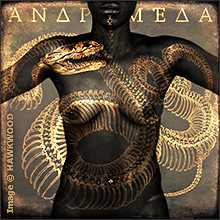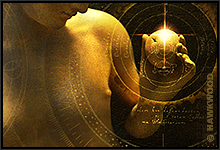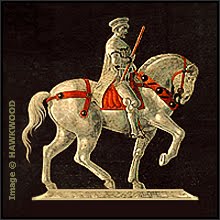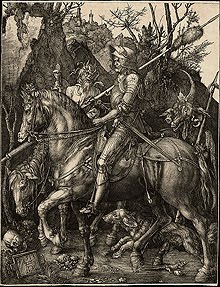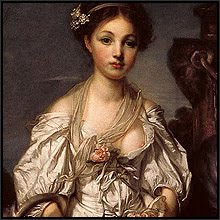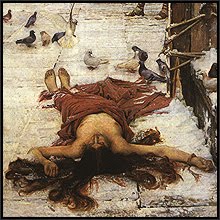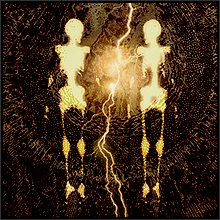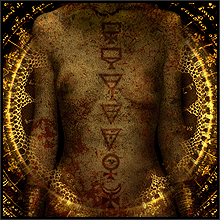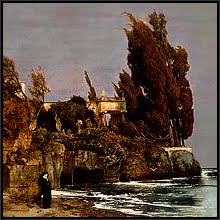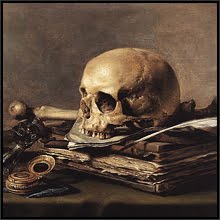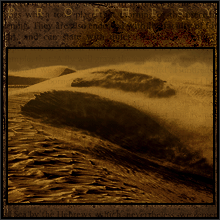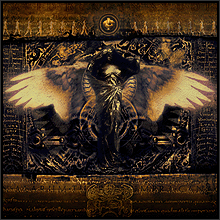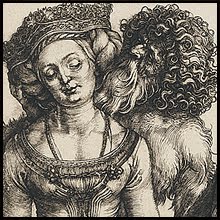Whether or not our beliefs endorse the account of Eve’s creation in the [1]second chapter of the Book of Genesis, even a charitable soul has to concede that the idea of a fully-grown woman being fashioned from a sleeping man’s rib and then being extracted from his side is a clumsy and disturbing image to get one’s head around. But as it nevertheless is a scene which is central to the Biblical creation story, it has both drawn and challenged artists, and its various depictions take in a spectrum ranging from bravura originality to pedestrian literalism and all shades in between.

Solomon J. Solomon’s The Birth of Eve (above) is surely one example from the top end of such a spectrum. It carries a force of conviction which sweeps us up into Eve’s drama, and we become willing believers in the scene – whether we buy into the Genesis account of her creation or not. Caressed by two supporting angels, the newly-emerged Eve rises from the flesh of a comatose Adam. All around her, swirls of new life eddy in vortices of charged energy, and we are left to guess whether her swooning pose indicates either the cathartic ecstasy of her creation, or the painful trauma of her emergence into the world. Perhaps these extremes of emotion lie close enough together for her to be experiencing both.
Earlier centuries clung more safely to the security of scriptural literalism, with the resulting imagery being both more pedantic and more unintentionally bizarre than the sensuality permitted by a later age. Bartolo di Fredi’s fresco (above) introduces what I irreverently think of as the 'Caesarean section' category of depictions of the scene. In a charmingly decorative Eden, a dark-robed God, supported on a hovering formation of red angels, offers the emerging Eve a steadying hand. Our sense of logic shouts to us that the fleshy space from which she emerges is an undersized impossibility, and we unconsciously suspect the unseen hollow chamber in the earth beneath the sleeping Adam, as we would suspect the stage illusionist’s concealing mirror which makes it appear as if his pretty assistant is emerging from an impossibly small box on a table.

His titan status in art history might lead us to expect something more from Michelangelo. But in the event, his depiction of the scene on the ceiling of the Sistine Chapel (above) is as banal as any other of its kind. Flanked by four extravagantly voluptuous male nudes which apparently had more to do with Michelangelo’s own [2]sexual preferences than they did with anything remotely Biblical, Eve steps out of Adam’s side with all the demure aplomb of a woman alighting from a bus. The artist balks at showing the actual physical opening of the flesh, and opts instead for a fudged compromise which gives the impression that Eve is in fact emerging from a cave behind the sleeping Adam, which summons an unwitting echo of the cave of birth featured in the pagan mystery schools of Ancient Greece right there on the ceiling of what is, after all, a Christian chapel.

What cannot be denied about Michelangelo is his iconic influence on subsequent depictions of these events. Although this influence is obvious in the engraving by Julius Schnorr von Carolsfeld (above), where Michelangelo gives us mere fleshy puppets, von Carolsfeld at least invests his characters with some humanity. God, appropriately larger-than-life and surrounded by rays of deific glory, blesses the wondering Eve who gazes steadfastly into her creator’s face as cloud-wreathed angels look on. The oblivious Adam, when he awakens, is in for a welcome surprise.

Henry Fuseli, better known for his dark portrayals of disturbing visions and nightmare visitations, provides us with an emerging Eve (above) straight from those worlds. In a scene of impenetrable inky shadows, both Eve and Adam swoon in apparent trauma as a uniquely clean-shaven and remarkably gothic God rolls his eyes to his own heaven. No comforting escorting angels here. All other details are swallowed up in the surrounding gloom, and even the relieving vegetation of Eden is replaced by an unyielding granite boulder. It is a secular interpretation which would have been impossible to consider before the romanticism of the late 18th- early 19th-century, and the more original for that.

Although he tends to be associated with the 19th-century pre-Raphaelites, George Frederick Watts was more of a visionary in line with such artists as Fuseli and William Blake. Watts tells us that he was inspired by contemplating the swirling patterns in carpets and wallpaper to produce his visions of winged angels and mystical beings, and his depiction of Eve’s emergence (above) seems to owe something to that technique of trippy visions. All superfluities are here dispensed with. Even the characters of God, Adam and the angels are brushed aside in the artist’s drive to produce an ecstatic vision of Eve becoming aware of her own existence, as she is borne up in the cloud of her own floating hair and the wreathing forms of the birds and flowers of Paradise. Watts, as with Fuseli, rode the wave of the Romantic movement in the arts to create a fabulous image whose rich sensuality would have been impossible for previous more scriptural centuries. But unlike Fuseli's bleak shadows, what we sense in Watts is the emergence of a new and intensely personal spirituality that we recognise as essentially contemporary in its quest.

With Martha Mayer Erlebacher’s creation of Eve (above) we have arrived in a radically different world. Eden now seems as bleak as the waste land which reaches to the uncertain horizon beyond, and the [3]legendary four rivers which flow out of Eden serve only to drive the focus towards the two central figures. But the figure lying on the bare ground is no slumbering Adam. Instead, what we are shown is an anonymous Caucasian female, with Eve as an African American woman. A more radically original version of the scene than this it is hard to imagine. Perhaps it took a woman to shake the original story loose from its Biblical literalism and offer us an interpretation which drives beyond all borders to reach new and questioning territory. Supernatural elements are not even hinted at in Erlebacher’s vision of things. Instead, we are confronted with stark and simple truths: that it is the woman who is the creator, that racial preconceptions have no place in scripture, and that even the earth of Eden can at times feel like cold, hard ground.
Hawkwood
Notes:
[1] Genesis 2:21-25 are the verses which relate how God fashioned Eve from a rib of the sleeping Adam. This and other events of the Creation directly contradict the version of the forming of the first unnamed man and woman in the preceding chapter (Genesis 1:27), in which the couple are created simultaneously with no mention of the rib. Some commentators take this discrepancy either as an indication that at least two versions by different writers have been combined in this part of Genesis, or that the Genesis 1 version of events actually refers to the couple of Adam and Lilith, Adam’s wife before Eve was created. Lilith, being created simultaneously with the first man, was therefore also his equal: a state of affairs that patriarchal scripture could not and would not tolerate, and Lilith was therefore edited out of the canonical version to linger instead in Hebrew legend.
[2] Please see my post Fear and Loathing in the Sistine Chapel for other examples of the ways in which Michelangelo’s homosexuality influenced the frescos which he produced for the ceiling of the Papal chapel.
[3] In Genesis 2:10-14, the four rivers are given as the Pison, Gihon, Hidekel (Tigris) and Euphrates. The identity of the first two remains speculative.
Sources:
Solomon J. Solomon: The Birth of Eve. Oils, 1908, Art Gallery of New South Wales (?), Australia. Up until 16 December, 2009, the painting was owned by the Ealing Borough Council, who due to increasing costs of upkeep, and security and conservation concerns, auctioned it through Christie's on that date for a hammer price of £713,250. ($1,159,031), a realized price just above its reserve price of £700,000. I have traced a photo of it on public exhibition after that date to the collection to the Art Gallery of New South Wales, which presumably is the new owner.
Bartolo di Fredi: The Creation of Eve. Fresco, 1456. Collegiate Church of San Gimignano, Italy.
Michelangelo Buonarroti: The Creation of Eve. Fresco, 1508-12, Sistine Chapel, Rome, Italy.
Julius Schnorr von Carolsfeld: The Creation of Eve. Engraving, 1825. One of a complete cycle of engravings which von Carolsfeld produced for an illustrated edition (at left) of the Bible.
Henry Fuseli: The Creation of Eve. Oils, 1791-93, Kunsthalle, Hamburg, Germany.
George Frederick Watts: She Shall be called Woman. Oils, 1875-92, Tate Gallery, London (not on public display at this time).
Martha Mayer Erlebacher: The Creation of Eve. Oils, 1996, private collection.



